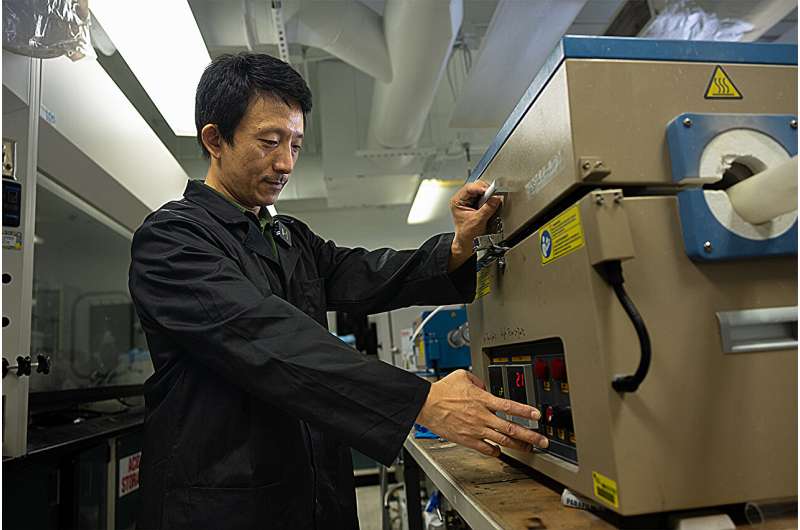This article has been reviewed according to Science X's editorial process and policies. Editors have highlighted the following attributes while ensuring the content's credibility:
fact-checked
peer-reviewed publication
trusted source
proofread
New device captures CO₂ and converts it to useful products

In an effort to reduce the environmental impact of carbon dioxide emissions, a University of Central Florida researcher has developed a new technology that captures carbon dioxide and outputs useful fuels and chemicals.
Yang Yang, an associate professor in UCF's NanoScience Technology Center, created an innovative device that captures carbon dioxide with a microsurface comprised of a tin oxide film and fluorine layer. The device then extracts gaseous carbon dioxide via a bubbling electrode and selectively converts the gases into carbon monoxide and formic acid, which are important raw materials for manufacturing chemicals.
This technology, detailed in a recent study in the Journal of the American Chemical Society, aims to reduce humanity's carbon footprint sustainably while addressing the need to produce alternative energy.
"We want to create a better technology to make our world better and cleaner," says Yang, who also is a member of UCF's Renewable Energy and Chemical Transformation (REACT) Cluster. "Too much carbon dioxide will have a greenhouse effect on the Earth and will heat it up very quickly. It's the motivation for why we want to develop this new material to grab and convert it into chemicals we can use."
This carbon dioxide capture technology could be located at power plants, industrial facilities, or chemical production plants where carbon dioxide is captured from emissions and converted into useful products.
Design blossomed from nature
The inspiration for the device and mitigating our impact on the environment came directly from nature itself, Yang says.
"We as scientists always learn from nature," he says. "We want to see how the animals and the trees work. For this work, we learned from the lotus. We know that the lotus has a really hydrophobic surface, which means when you drop water on the surface, the water will go quickly away from the surface. We also know that green plants absorb carbon dioxide and convert it to oxygen through photosynthesis."
The lotus helped Yang conceive of carbon dioxide capture technology that mimics the lotus surface, in which water trickling down a device's fabricated hydrophobic surface would be separated from the carbon dioxide conversion reaction.
It's necessary to carefully manage the amount of water on the surface of materials that may flood the device or disrupt carbon dioxide conversion, Yang says.
Once captured, the carbon dioxide gas is then routed through an electrode and converted through a more customizable process than naturally occurring photosynthesis.
The electrocatalytic carbon dioxide reduction reaction converts carbon dioxide gas into carbon-containing chemicals, such as methanol, methane, ethylene, ethanol, acetate, and propanol, depending on the specific reaction pathways on the catalysts.
"We want to create a better material which can quickly grab carbon dioxide molecules from the air and convert them into chemicals," Yang says. "We just reduce the concentration of carbon dioxide in the air and convert it in the liquid and gas phase so we can directly use those converted chemicals and fields for other applications."
One of the most challenging components of the research was reducing the amount of water spread out on the surface of the catalytic materials when exposing the components of gaseous carbon dioxide in the liquid electrolyte, he says.
"If you have too much water surrounding your materials, you may produce hydrogen instead of converting carbon dioxide to chemicals," Yang says. "That will decrease the energy efficiency of the overall process. The materials we use can repel the water from the surface, so we can avoid the formation of hydrogen, and we can greatly enhance the carbon dioxide reduction efficiency. So that means eventually we can use almost all of the electricity for our reaction."
Scaling up
There are many existing efforts around the world to reduce, capture or convert carbon dioxide, including planting trees and developing large-scale carbon dioxide capture technologies. Yang says he hopes the carbon dioxide capture and conversion device may serve as a viable alternative option to other more time-consuming or costly methods.
Harnessing environmentally sustainable electricity is another step in implementing the carbon dioxide conversion technology into reality, Yang says.
"In our process, we can use intermittent electricity, like the electricity coming from the solar panel or from the wind farm," he says.
The technology is built off Yang's previous energy efforts at UCF nearly three years ago in developing new materials for fuel cells that used fluorine-enhanced carbon.
The research serves as an important first step and is a fundamental study that may pave the way for more large-scale carbon dioxide capture methods, Yang says.
"For this, we validated our concept from the fundamental point of view," he says. "We tested the performance in our reactors, but in the future, we want to develop a bigger prototype that can show people how quickly we can convert and reduce the carbon dioxide concentration and generate chemicals or fuels very quickly from our large-scale prototype."
Researchers, students and postdoctoral scholars from UCF's Department of Materials Science and Engineering, NanoScience Technology Center and Department of Chemistry include Lei Zhai; Fnu Joshua, MS; David Fox, PhD; Shengwen Liu; Zhao Li, PhD; Jinfa Chang; Guanzhi Wang, PhD; Ao Yu; and Wei Zhang, PhD.
Yang also collaborated with the University of Houston; the University of California, Berkeley; Stanford University and the Eastern Institute for Advanced Study in Ningbo, China.
More information: Wei Zhang et al, Dynamic Bubbling Balanced Proactive CO2 Capture and Reduction on a Triple-Phase Interface Nanoporous Electrocatalyst, Journal of the American Chemical Society (2024). DOI: 10.1021/jacs.4c02786


















